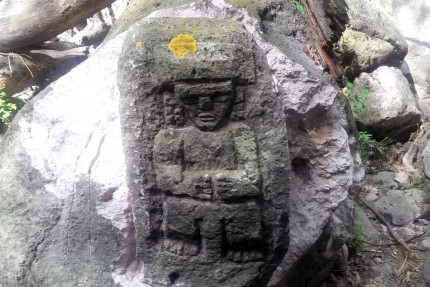
A tourist hiking in the foothills of a waterfall in Mexico two weeks ago fell from a branch onto a Mesoamerican monolith that was in the process of being carved out of the stone by looters. You’d think looters would be deterred by the weight of the stone — an estimated 10 tons — and its size — five feet wide, five feet high and almost seven feet deep — but no; they just started cutting the carving out of it, removing the porous red volcanic cantera stone around the figure which is about a foot and a half wide and two and a half feet high. Given enough time they would have gotten away with it too, if it weren’t for that pesky hiker falling out of a tree.
The tourist reported the find to the authorities in the nearby city of Calvillo in the central Mexican state of Aguascalientes who in turn called in regional experts from the National Institute of Anthropology and History (INAH). Archaeologists examined the monolith and discovered it’s a unique piece of major historical import in the region. Carved in the image of a man with a headdress and earrings, its location near a waterfall and spring suggests a connection to a deity.
The figure shows a strong influence of Teotihuacan style from between 200 to 600 A.D. The urban center of Teotihuacan was 350 miles southeast of Calvillo, but its cultural sphere of influence was vast. Before now, however, archaeologists thought the local culture was entirely Chichimeca, nomadic hunter-gatherers of varied language and ethnicity, but no artifacts this old have been found in the state before. It significantly predates known Chichimeca settlements in the area.
In order to keep it safe from human depredation, experts will be completing the looters’ work. The 10-ton stone is simply too big and unwieldy to remove. It’s in the wilderness where there are no roads. It would require specialized equipment and a cargo helicopter to air lift it out of the jungle, and officials have neither the material nor the funding to make that happen. Instead, they’ve installed a shelter around the stone and will have a joint police and army surveillance team on site while archaeologists detach the carved figure from its rocky home. The operation is expected to take 15 days to a month.
Once it’s been removed, the carving will be kept at the INAH lab where archaeologists can study it fully. Its ultimate destination will be the Municipal Museum that is currently under construction in Calvillo.